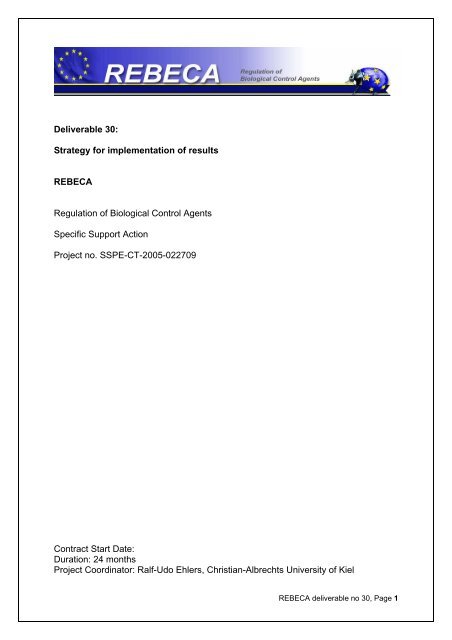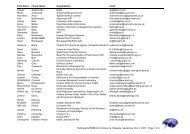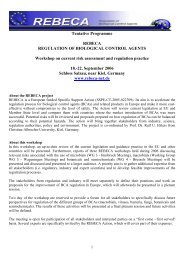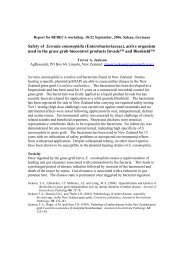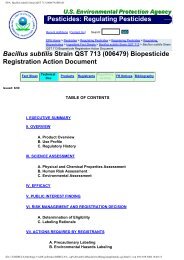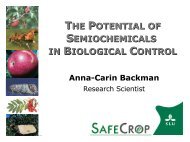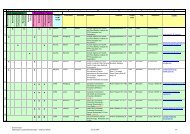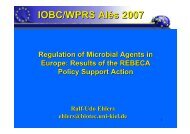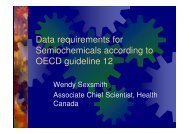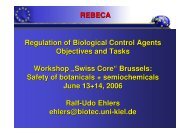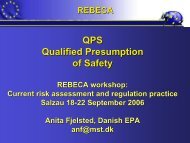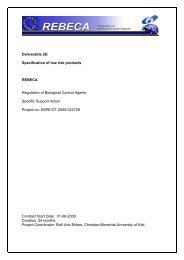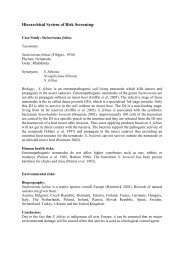Deliverable 30: Strategy for implementation of results REBECA ...
Deliverable 30: Strategy for implementation of results REBECA ...
Deliverable 30: Strategy for implementation of results REBECA ...
- No tags were found...
Create successful ePaper yourself
Turn your PDF publications into a flip-book with our unique Google optimized e-Paper software.
<strong>Deliverable</strong> <strong>30</strong>:<strong>Strategy</strong> <strong>for</strong> <strong>implementation</strong> <strong>of</strong> <strong>results</strong><strong>REBECA</strong>Regulation <strong>of</strong> Biological Control AgentsSpecific Support ActionProject no. SSPE-CT-2005-022709Contract Start Date:Duration: 24 monthsProject Coordinator: Ralf-Udo Ehlers, Christian-Albrechts University <strong>of</strong> Kiel<strong>REBECA</strong> deliverable no <strong>30</strong>, Page 1
Document ClassificationTitle<strong>Strategy</strong> <strong>for</strong> <strong>implementation</strong> <strong>of</strong> <strong>results</strong><strong>Deliverable</strong> <strong>30</strong>Reporting Period 2Contractual Date <strong>of</strong> Delivery December 2007Actual Date <strong>of</strong> Delivery December 2007AuthorsWork packageDisseminationNatureVersionKeywordsAnita FjelstedWP7PublicReport1.0 FinalImplementationDocument HistoryThe document is based on the recommendations from a questionnaire (“mainobstacles and proposals”, 2006), as well as discussions and recommendationsexpressed at the following 8 <strong>REBECA</strong> workshops:1. Innsbruck workshop on microbials April 2006;2. Brussels workshop on botanicals and semiochemicals June 2006;3. Salzau workshop in September 2006;4. Regulators and industry workshops in Salzau June 2006;5. Regulators workshop in Braunschweig, Germany April 2007;6. Cost-benefit workshop in Finland May, 2007;7. Brussels workshop on botanicals and semiochemicals June 2007;8. Final conference in Brussels September 2007.Document AbstractThis document presents a list <strong>of</strong> all the <strong>REBECA</strong> proposals apart from the proposalson invertebrate BCAs, (please refer to deliverable 22 <strong>for</strong> in<strong>for</strong>mation regarding<strong>implementation</strong> <strong>of</strong> proposals related to invertebrate regulation) and <strong>for</strong> each proposalit describes how it can be implemented, who will be the responsible partner <strong>for</strong>implementing it, and a suggestions <strong>for</strong> timeframe within which the process <strong>for</strong><strong>implementation</strong> should be initiated and where relevant when it should be finalised.<strong>REBECA</strong> deliverable no <strong>30</strong>, Page 2
Table <strong>of</strong> contentsIntroduction................................................................................................................. 41. General regulation <strong>of</strong> microbials, botanicals and semiochemicals.......................... 52. Microbials ............................................................................................................. 133. Botanicals ............................................................................................................. 174. Semiochemicals ................................................................................................... 19<strong>REBECA</strong> deliverable no <strong>30</strong>, Page 3
IntroductionThe aim <strong>of</strong> the <strong>REBECA</strong> project is to propose improvements in the registrationprocess <strong>of</strong> biological control agents (microbials as well as invertebrate biocontrolagents), plant extracts and semiochemicals (here collectively called ‘BCAs’).This document contains an overview <strong>of</strong> all the <strong>REBECA</strong> proposals which have beenagreed upon within the group throughout the project period (apart from the proposalsregarding invertebrate BCA). For each proposal the possible measures to obtain an<strong>implementation</strong> <strong>of</strong> the proposals are suggested; the partners that will be responsibleand involved in the <strong>implementation</strong> process; expected timeframe <strong>for</strong> the initiation <strong>of</strong>the <strong>implementation</strong>.The proposals and measures <strong>for</strong> <strong>implementation</strong> are listed in the following fourtables:1. General regulation <strong>of</strong> microbials, botanicals and semiochemicals2. Microbials3. Botanicals4. SemiochemicalsThe <strong>REBECA</strong> project also includes a workpackage on invertebrate biocontrol agents.The main proposal from that workpackage is the establishment <strong>of</strong> a pan-Europeanregulatory system <strong>for</strong> invertebrate BCAs. The options <strong>for</strong> implementing such asystem are described in a separate document (refer to <strong>Deliverable</strong> No 22).<strong>REBECA</strong> deliverable no <strong>30</strong>, Page 4
1. General regulation <strong>of</strong> microbials, botanicals and semiochemicalsAll the listed proposals in this first table have been discussed in details during several <strong>REBECA</strong> workshops. For further in<strong>for</strong>mationabout each specific proposal please consult the <strong>REBECA</strong> document: Proposals on how to accelerate regulation and reduction <strong>of</strong> fees(<strong>Deliverable</strong> No 27). This document contains a detailed background <strong>for</strong> all the proposals, further description <strong>of</strong> the proposals and lists<strong>of</strong> advantages and disadvantages <strong>of</strong> the proposals.Proposal Measures to obtain <strong>implementation</strong> Level <strong>of</strong><strong>implementation</strong>Improved communication between regulators and applicantsInvolvedpartnersTimeframePre-submission meetingsshall be established as aroutine in all EU MemberStates.There is a need <strong>for</strong> an EU guidance document. The Commission(DG Sanco) should initiate this work by asking a small expertgroup representing a few member states (alternatively ask a singlemember state) to prepare a first draft guidance document whichwill subsequently be discussed among all member states andfinally agreed upon and taken note <strong>of</strong> by the Standing Committee<strong>of</strong> Food Safety and Animal Health.The guidance document should describe: the purpose <strong>of</strong> presubmissionmeetings; a model describing how to carry out thesemeetings; and it should include specification <strong>for</strong> the presubmissionin<strong>for</strong>mation package (see below).In case any expenses (travel expenses) will be involved in thiswork it should be covered by the Commission.EU and nationallevelTheCommission(DG Sanco),all EUmemberstates2008in<strong>for</strong>ma-Pre-submissiontion packageA detailed description on how to prepare a pre-submissionin<strong>for</strong>mation package should be initiated by the Commission (DGSanco) and developed by the same expert group as mentionedabove. This description should be part <strong>of</strong> the above mentioned EUguidance document.A similar description exists in the US-EPA and in the PestEU and nationallevelTheCommission(DG Sanco),all EUmemberstates2008<strong>REBECA</strong> deliverable no <strong>30</strong>, Page 5
Proposal Measures to obtain <strong>implementation</strong> Level <strong>of</strong><strong>implementation</strong>Management Regulatory Agency, Canada. These documents canbe used as a basis <strong>for</strong> this work within EU.A first draft <strong>of</strong> such a pre-submission in<strong>for</strong>mation package isdescribed in <strong>REBECA</strong> <strong>Deliverable</strong> No 27.A more detailed proposal on a pre-submission in<strong>for</strong>mationpackage <strong>for</strong> micro-organisms is described in the table onmicrobials below.Applicants given theopportunity <strong>of</strong> attendingpart time atexpert/evaluationmeetingsThe usefulness <strong>of</strong> such a system will first <strong>of</strong> all have to bediscussed by the EFSA, the Commission (DG Sanco) and memberstates. If it will be agreed to allow applicants attending part time atthe expert meetings (which are normally hosted by the EFSA).EFSA should establish a routine where they prior to each expertmeeting remind the Rapporteur member states responsible <strong>for</strong> theactive ingredients listed on the agenda to consider whether itwould be relevant inviting the involved applicants to participate inpart <strong>of</strong> the expert meeting.The Rapporteur member state would subsequently be responsible<strong>for</strong> the communication and agreement with the applicant.The applicants would <strong>of</strong> course have to cover the travel expenses<strong>for</strong> attending such meetings them selves.InvolvedpartnersEU level EFSA, TheCommission(DG Sanco)and all EUmemberstatesTimeframe2008Improved communication between regulators <strong>of</strong> BCAsEnlargement <strong>of</strong> theOECD-BPSG and furtheractivities to take placewithin the groupThe OECD Bio-Pesticide Steering Group should be given higherpriority by OECD member states. 1) Further experts should attendthe meetings; 2) further resources from national regulatoryauthorities should be allocated to activities in relation to this group(expenses to attend meetings, expertise to develop guidanceOECD levelOECD-BPSGand theOECDmemberstates2008-…<strong>REBECA</strong> deliverable no <strong>30</strong>, Page 6
Proposal Measures to obtain <strong>implementation</strong> Level <strong>of</strong><strong>implementation</strong>documents and papers <strong>for</strong> discussion in the group etc.); 3) Furthermeetings/workshops should be arranged within the group.An OECD-BPSG workshop will take place in Washington DC inApril 2008. One <strong>of</strong> the main points on the draft agenda isincreased communication between regulators including presubmissionmeetings and pre-submission in<strong>for</strong>mation package.Further and more regularexpert-/evaluationmeetings on the specificgroups <strong>of</strong> BCAsWhen active substances such as micro-organisms, botanicals orsemiochemicals will be discussed in expert meetings, thesemeetings should be arranged specifically <strong>for</strong> each <strong>of</strong> these types <strong>of</strong>active substances, and the meetings should be arranged as <strong>of</strong>tenas necessary. Such meetings should be attended by people withhigh level <strong>of</strong> expertise within these particular fields. This will inparticular be relevant during the evaluation <strong>of</strong> the 4 th listsubstances, where specific meetings on microbials, botanicals orsemiochemicals should be arranged.EFSA is responsible <strong>for</strong> planning such meetings and <strong>for</strong> invitingthe relevant national experts.InvolvedpartnersEU level EFSA 2008TimeframeEstablish expert groups<strong>for</strong> BCAsAs soon as possible, the EFSA should ask member states tonominate national experts/regulators <strong>for</strong> three expert groups, sincethe EFSA does not have expertise to deal with these specialisedfields:1. Microbials (such a group already exists and is establishedby the Commission, however the EFSA should take overthis role and establish a <strong>for</strong>mal group and further expertsshould be encouraged to join the group)2. Botanicals3. SemiochemicalsEU level EFSA 2008<strong>REBECA</strong> deliverable no <strong>30</strong>, Page 7
Proposal Measures to obtain <strong>implementation</strong> Level <strong>of</strong><strong>implementation</strong>One member state should be appointed as chair <strong>for</strong> the group.EFSA should make the necessary funding available <strong>for</strong> regularmeetings within these groups.InvolvedpartnersTimeframeLessons learned guidance documents from the 4 th stageLessons learnedguidance documents tobe used in presubmissionmeetings todeterminedatarequirements/ waiversand generic safetypr<strong>of</strong>ilesMember states involved in the preparation <strong>of</strong> 4 th list DARs onmicrobials, semiochemicals and botanicals should write severallessons learned guidance documents that can be used byapplicants and regulators evaluating such types <strong>of</strong> substances inthe future.These documents should be discussed within the three expertgroups established (semiochemicals, botanicals and microbials). Ifrelevant, the documents could be further developed into OECDguidance documents. At least they should be communicated toe.g. the OECD BioPesticide Steering Group.National level, EUlevel, OECD levelCoordinationby the expertgroups/chairs<strong>of</strong> thesegroupsRapporteurmemberstates2008-2009Fees and financial supportFees <strong>for</strong> microbials andsemiochemicals to belowered substantiallyA few member states take large fees <strong>for</strong> reviewing activesubstances <strong>of</strong> low risk (e.g. microbials) since <strong>of</strong>ten the work has tobe carried out on a cost-recovery basis. The grower’sorganisations, consumer organisations and the industry shouldinitiate political discussions within these member states in order torequest further low risk products on the market and suggestreduced fees. In most cases a political decision to lower the feeshas to take place.National levelGrower’sorganisations,Consumerorganisation,Industry,regulators,policy people.2008- …<strong>REBECA</strong> deliverable no <strong>30</strong>, Page 8
Proposal Measures to obtain <strong>implementation</strong> Level <strong>of</strong><strong>implementation</strong>Financial support andguidance <strong>for</strong> registration<strong>of</strong> new microbials,botanicalsandsemiochemicalsGeneric approach in risk assessmentRegulatory authorities and ‘policy people’ should take active part insuch discussions.Only a few member states have a specific policy that supports anincrease in the number <strong>of</strong> low risk products/alternative plantprotection products on their market. The grower’s organisations,organic farming organisations, consumer organisations and theindustry should initiate political discussions within member stateswith the view to: get politicians and regulators to focus on thepotential <strong>of</strong> these products; request the regulators to give higherpriority to such products and to give further guidance to applicants<strong>of</strong> such product types; raise funds that can support the applicationprocess <strong>of</strong> such products.Apart <strong>for</strong>m such activities at national level, internationalorganisations (consumer organisations, grower organisations,NGOs, organic farming organisations) should initiate similardiscussions at EU level.Regulators should take active part in such discussions. Furthermore regulators from member states where such activities havebeen initiated should regularly communicate the experience andeffect <strong>of</strong> such initiatives to their colleagues.National level andEU levelInvolvedpartnersNational andinternationalGrower’sorganisations,Consumerorganisation,Industry,regulatorsTimeframe2008- …Establishriskmanagement strategiestaking a generic approachwherever possible –evaluating certain activesubstances as a groupWhen applicants submit applications <strong>for</strong> new BCAs they should inthe dossier stress if they believe that certain part <strong>of</strong> the dossier isan issue that can be dealt with by a generic approach, (e.g. fungalmetabolites) and the dossier should contain a detailed reasoning<strong>for</strong> this.Regulators should always be open <strong>for</strong> discussions with applicantson possibilities <strong>of</strong> evaluating certain active substances as a group,EU levelApplicantsandregulators2008 - …<strong>REBECA</strong> deliverable no <strong>30</strong>, Page 9
Proposal Measures to obtain <strong>implementation</strong> Level <strong>of</strong><strong>implementation</strong>e.g. microorganisms at a higher taxonomic level, certainsemiochemical groups, etc. A more generic approach can takeplace <strong>for</strong> active substances when adequate experience and data isavailable <strong>for</strong> such generic evaluations.InvolvedpartnersTimeframeStrict and short timelinesStrict and short timelines<strong>for</strong> the EU riskassessment as well as <strong>for</strong>national registrationsshould be included in theEU regulationApplicants and regulators should be in close contact prior to thesubmission <strong>of</strong> an application (pre-submission meetings etc.) whichis likely to result in a submission <strong>of</strong> good and complete dossiers,which the regulators thus will find easy to evaluate.As mentioned above, an increased political awareness andsupport is likely to secure further resources <strong>for</strong> the regulatorswhich will help them to be able to carry out the risk assessmentwithin a short timeframe, provided the necessary data are includedin the dossier.The alternative/low risk substances should be given high priorityduring the EU evaluations. Expert meetings discussing theseproduct types should take place regularly and without delay. Asalready mentioned applicants should attend part time at suchmeetings to solve potential misunderstandings and answerquestions right away, which is likely to speed up the procedure.Member states to agree on strict and short timelines <strong>for</strong> the EUand national evaluations/authorisations.In the new regulation to replace Directive 91/414/EEC stricttimelines are included (also <strong>for</strong> national applications based onmutual recognition/zonal approach). However, this is still underdiscussion in Council.National and EUlevelApplicants,regulators,EFSA, theCommission,memberstates2008- …<strong>REBECA</strong> deliverable no <strong>30</strong>, Page 10
Proposal Measures to obtain <strong>implementation</strong> Level <strong>of</strong><strong>implementation</strong>Efficacy evaluationInvolvedpartnersTimeframePotentialfutureintroduction <strong>of</strong> efficacyevaluation into the EUevaluation needs to beaccompanied by aguidance document onevaluation criteria in orderto obtain a harmonisedefficacy evaluationbetween the memberstates.Authorities should acceptmodified trial protocols,provided that theapplicant can justify themodifications (e.g. <strong>for</strong>semiochemicals andmicrobials)EFSA should establish an efficacy expert group consisting <strong>of</strong>efficacy experts from a number <strong>of</strong> member states and the EFSA.Through meetings and other means <strong>of</strong> communication this groupshould draft guidance documents describing requirements <strong>for</strong>efficacy data and criteria <strong>for</strong> BCAs. It should contain guidance <strong>for</strong>each <strong>of</strong> the three groups: microbials, botanicals andsemiochemicals.The draft should subsequently be discussed among all memberstates and finally be taken note <strong>of</strong> by the Standing Committee <strong>of</strong>Food Safety and Animal Health.However, some <strong>of</strong> the suggested changes here will need to beincluded in the negotiations <strong>of</strong> the new regulation e.g.: theproposal <strong>of</strong> giving authorisations <strong>for</strong> 5 years followed by data onefficacy.A first guidance document/position paper on efficacy <strong>for</strong> microbialshas recently been prepared by the OECD-BPSG.EU and nationallevelEFSAmemberstatesand2008-2009Long-term effects oninsect populations <strong>of</strong> e.g.semiochemicals orbaculoviruses should aswell be considered sincethe effect may not beobserved until the nextgeneration or thefollowing year.Data requirements should<strong>REBECA</strong> deliverable no <strong>30</strong>, Page 11
Proposal Measures to obtain <strong>implementation</strong> Level <strong>of</strong><strong>implementation</strong>be flexible and adapted tothe special properties <strong>of</strong>the particular type <strong>of</strong>active substance.Products with minorbeneficial effects shouldbe acceptable.If the active substance isnot directly applied tocrops(e.g.semiochemicals) thereshould not be arequirement <strong>for</strong> cropdestruction after efficacytrials.To avoid unnecessaryrepetition <strong>of</strong> experimentalwork, the use <strong>of</strong> efficacydata from other areasshould be activelyencouragedFor low risk substances, itshould be possible to get5 year registrationswithout presentingefficacy data. During the 5years <strong>of</strong> market useefficacy data should begeneratedandsubsequently bepresented <strong>for</strong> furtherInvolvedpartnersTimeframe<strong>REBECA</strong> deliverable no <strong>30</strong>, Page 12
Proposal Measures to obtain <strong>implementation</strong> Level <strong>of</strong><strong>implementation</strong>registrations after the 5years.InvolvedpartnersTimeframe2. MicrobialsFor further in<strong>for</strong>mation about each specific proposal please consult the <strong>REBECA</strong> document: Proposals <strong>for</strong> improved regulatoryprocedures <strong>for</strong> microbial BCA (<strong>Deliverable</strong> 10).Proposal Measures to obtain <strong>implementation</strong> Level <strong>of</strong><strong>implementation</strong>BaculovirusesInvolvedpartnersTimeframeAnnex I inclusion <strong>of</strong>Baculoviruses at a highertaxonomic level than atisolate levelA <strong>REBECA</strong> proposal was discussed among all stakeholders at a<strong>REBECA</strong> meeting and afterwards in the EU Microbial ExpertGroup, where the proposal was agreed upon. This proposal hasnow been implemented. The first Baculovirus species (Spodopteraexigua NPV) was included in Annex I, and came into <strong>for</strong>ce on 1 stDecember 2007. A guidance document on the procedure wastaken note <strong>of</strong> by the Standing Committee <strong>of</strong> Food Safety andAnimal Health in January 2008. The proposal has thus successfullybeen implemented.EU level<strong>REBECA</strong>stakeholders, EUmicrobial expertgroup, theCommission2007Proposal on thresholdlevels <strong>for</strong> microbialcontamination inBaculovirus productsThe above mentioned <strong>REBECA</strong> proposal contained a table withthreshold levels <strong>of</strong> microbial contaminants. This part <strong>of</strong> theproposal as well as a Canadian proposal <strong>for</strong> an OECD guidancedocument on threshold levels <strong>of</strong> microbial contaminants in allmicrobial plant protection products should be further discussedOECD and EUlevelOECD-BPSG,EU microbialexpert group2008-2009<strong>REBECA</strong> deliverable no <strong>30</strong>, Page 13
Proposal Measures to obtain <strong>implementation</strong> Level <strong>of</strong><strong>implementation</strong>within the OECD BioPesticide Steering Group. The output shouldbe an OECD agreed guidance document on threshold levels <strong>for</strong>microbial contaminants in all types <strong>of</strong> microbial plant protectionproducts.InvolvedpartnersTimeframeData requirementsSimplified dossierpreparation based on apre-submissionin<strong>for</strong>mation packageThe <strong>REBECA</strong> proposal with a detailed list <strong>of</strong> in<strong>for</strong>mation/datarequired <strong>for</strong> the pre-submission in<strong>for</strong>mation package <strong>for</strong> microbialsshould be further discussed within a specialised group such as theEU microbial expert group as well as in the OECD BPSG. Thereare two possibilities: preferably an OECD guidance documentshould be developed alternatively the EU expert group shoulddevelop a proposal <strong>for</strong> an EU guidance document which shouldsubsequently be discussed among all EU member states andfinally taken note <strong>of</strong> in the Standing Committee <strong>of</strong> Food Safety andAnimal Health.EU level orOECD levelEU microbialexpert group,OECD BPSG,EFSA, allmember states,the Commission2008- …The document should include criteria <strong>for</strong> waivers <strong>of</strong> data and adecision tree allowing applicants to submit a simplified dossier.The expenses <strong>for</strong> meetings required <strong>for</strong> the EU microbial expertgroup to discuss the in<strong>for</strong>mation package should be covered by theEFSA.More specific datarequirements/ deletion <strong>of</strong>some data requirements/description <strong>of</strong> waivers <strong>for</strong>a number <strong>of</strong> dataAfter the adoption <strong>of</strong> a new EU regulation <strong>of</strong> plant protectionproducts (expected in 2008), it is anticipated that within 18 monthsfrom the date the regulation will come into <strong>for</strong>ce the present EUdata requirements should be revised and transferred intoone/several EU regulations.EU level EU microbialexpert group,EFSA, all EUmember states,The2008-…<strong>REBECA</strong> deliverable no <strong>30</strong>, Page 14
Proposal Measures to obtain <strong>implementation</strong> Level <strong>of</strong><strong>implementation</strong>requirements:Genetic stabilityHuman infectivity andother toxicological datarequirementsExposure dataSensitisationMetabolitesPersistance in theenvironmentEco-toxicology and nontargetorganismsLow riskIt is there<strong>for</strong>e important that the EU microbial expert group soonshould start discussions on certain parts <strong>of</strong> the data requirementstaking into account the lessons learned since adoption <strong>of</strong> thepresent data requirements. A new proposal <strong>of</strong> data requirementsshould be proposed and discussed among all member states andfinally adopted as a new regulation not later than 18 months afterthe new EU regulation <strong>of</strong> plant protection products have come into<strong>for</strong>ce.Apart <strong>of</strong> a slightly revised set <strong>of</strong> data requirements, a number <strong>of</strong>guidance documents should be developed. Partners, who shouldbe involved in preparing such guidance documents is, apart fromregulators and national experts, the industry (IBMA) and academia.The expenses <strong>for</strong> the meetings required <strong>for</strong> the EU microbial expertgroup to discuss the data requirements and the guidancedocuments should be covered by the EFSA.InvolvedpartnersCommission,Industry,AcademiaTimeframeDeveloping a risk index tocomparatively assessenvironmental risks posedby microbial andconventional pest controlagents.The tool could in the future be used to distinguish between highand low risk active substances/product types, and thereby indicatewhich active substances should be included into Annex I <strong>for</strong> e.g. 15years as opposed to 10 years (according to the Commissionproposal <strong>for</strong> a new EU regulation).It could help member states to distinguish between high and lowrisk products in case these member states would like todifferentiate the taxes on pesticides and fees <strong>for</strong> evaluation andauthorisation <strong>of</strong> products. Further more the tool could giveguidance to growers that would like to comply with rules <strong>for</strong> IPM.This will be important after the framework directive <strong>of</strong> sustainableEU/OECDlevelOECD RiskReductionSteering groupand BPSG, TheCommission, EUmember states2008 - …<strong>REBECA</strong> deliverable no <strong>30</strong>, Page 15
Proposal Measures to obtain <strong>implementation</strong> Level <strong>of</strong><strong>implementation</strong>use <strong>of</strong> pesticides have come into <strong>for</strong>ce.The proposal should be discussed in the OECD Risk ReductionSteering Group and among member states and the Commissionduring the period <strong>of</strong> negotiation <strong>of</strong> a new EU regulation.A seminar attended by the OECD Risk Reduction Steering Groupand the Bio Pesticide Steering Group on “Identification <strong>of</strong> barriersand risks <strong>for</strong> low risk plant protection products & biocides” is<strong>for</strong>eseen.InvolvedpartnersTimeframe<strong>REBECA</strong> deliverable no <strong>30</strong>, Page 16
3. BotanicalsFor further in<strong>for</strong>mation about each specific proposal please consult the <strong>REBECA</strong> document: Improved regulatory procedures <strong>for</strong>botanicals and semiochemicals and list <strong>of</strong> knowledge gabs (<strong>Deliverable</strong> No 16).Proposal Measures to obtain <strong>implementation</strong> Level <strong>of</strong><strong>implementation</strong>Data requirementsInvolvedpartnersTimeframeA new guidancedocument should cover allplant extracts.Relaxation on dataregarding identification <strong>of</strong>plant constituents that arenot the active substance.These substances shouldbe characterized by groupanalysis.It should not be necessaryto achieve 98% closure.EFSA should as soon as possible establish an EU expert group onbotanicals. This group, consisting <strong>of</strong> RMS from the 4 th listbotanicals, other experts from member states, the Commission andthe EFSA, should during and after the EU evaluation <strong>of</strong> the 4 th listbotanicals further develop the draft document SANCO/10472 andsubsequently ask the Standing Committee <strong>of</strong> Food Safety andAnimal Health to take note <strong>of</strong> such a guidance document onbotanicals.Expenses <strong>for</strong> the meetings required <strong>for</strong> the EU Botanical expertgroup to discuss the guidance document should be covered by theEFSA.EU level EFSA andthe EUBotanicalexpert group,all memberstates2008 - …Quality assurance/manufacturing methods:The methods <strong>of</strong>manufacture should bedescribed in an adequatemanner, taking intoaccount measures toprevent the <strong>for</strong>mation <strong>of</strong>hazardous microbialdecay products duringmanufacture.<strong>REBECA</strong> deliverable no <strong>30</strong>, Page 17
Proposal Measures to obtain <strong>implementation</strong> Level <strong>of</strong><strong>implementation</strong>Low riskInvolvedpartnersTimeframeBotanicals <strong>of</strong> lowrisk/concern should beidentified early in theapplication/evaluationprocess and be subject toreduceddatarequirementsIn general applicants and national regulatory authorities shouldmeet early in the application process (at pre-submission meetings)and discuss this issue in order to agree on waivers. If specificissues need further discussion, these can be put <strong>for</strong>ward <strong>for</strong>discussions in the EU Botanical expert group.EU level andnational levelApplicants,RMS,Botanicalexpert group2008 - …During the preparation <strong>of</strong>the dossier as well asduring evaluation andregistration the history <strong>of</strong>safe use in plantprotection should be takeninto account as well as theuse <strong>for</strong> other purposes(e.g. food ingredients)Regulators and applicants should discuss this issue at the presubmissionmeetings and later in the process within the Botanicalexpert group.EU level RMS andBotanicalexpert group2008 - …<strong>REBECA</strong> deliverable no <strong>30</strong>, Page 18
4. SemiochemicalsFor further in<strong>for</strong>mation about each specific proposal please consult the <strong>REBECA</strong> document: Improved regulatory procedures <strong>for</strong>botanicals and semiochemicals and list <strong>of</strong> knowledge gabs (<strong>Deliverable</strong> No 16).Proposal Measures to obtain <strong>implementation</strong> Level <strong>of</strong><strong>implementation</strong>The process <strong>of</strong> Annex I inclusionInvolvedpartnersTimeframeCollective listing <strong>of</strong>Straight-chainedLepidopteranPheromones (SCLP) inAnnex IAs already mentioned, the EFSA should establish an expertgroup on semiochemicals as soon as possible. When the DAR<strong>for</strong> the 4 th list group <strong>of</strong> SCLP has been finalised the EFSAshould initiate a discussion within the expert group on this issue(as well as the issues below). The group should communicatetheir conclusion to the Standing Committee <strong>of</strong> Food Safety andAnimal Health preferably as a short guidance document whichthe Standing Committee should take note <strong>of</strong>.EU level EFSA andSemiochemicalexpert group2008SCLP should beregarded as low risksubstances, as defined inthe draft <strong>for</strong> the newregulation <strong>of</strong> plantprotection products (art.22 and 46)This proposal should be discussed by the Semiochemical expertgroup after the finalisation <strong>of</strong> the EU risk assessment <strong>of</strong> the 4 thlist SCLPs (and the new regulation has come into <strong>for</strong>ce).EU levelSemiochemicalexpert group2008-2009Data requirements <strong>for</strong> SCLPRelaxations on the datarequired <strong>for</strong> theevaluation <strong>of</strong> “impurities”which are themselvesAll the proposals regarding data requirements <strong>for</strong> SCLP shouldbe discussed in the Semiochemical expert group (consisting <strong>of</strong>the RMS <strong>for</strong> the 4 th list SCLPs, the EFSA, the Commission andseveral experts from member states). Either specific dataEU level andOECD levelExpert group onsemiochemicals,comprising:RMS, The EFSA2008-…<strong>REBECA</strong> deliverable no <strong>30</strong>, Page 19
Proposal Measures to obtain <strong>implementation</strong> Level <strong>of</strong><strong>implementation</strong>SCLPrequirements <strong>for</strong> SCLP pheromones should be developed or anEU guidance document which should subsequently be takennote <strong>of</strong> by the Standing Committee.Relaxation on request <strong>for</strong>5 batch analysis <strong>for</strong>SCLP that are only rarelyproducedRelaxations on the datarequired <strong>for</strong> evaluation <strong>of</strong>SCLPs which are used inquantities comparable tonatural emissions (up to375 g/ha per year)Data requirements <strong>for</strong> other semiochemicalsIn order to obtain harmonisation, these issues should also bediscussed within the OECD BioPesticide Steering Group.The OECD-Guidance document 12 need to be revised.Involvedpartnersand theCommission.OECD-BPSGTimeframeCase-by-case relaxationson the data required <strong>for</strong>evaluation <strong>of</strong> othersemiochemicals takinginto account the naturalemissions and the history<strong>of</strong> exposure to thesubstance.More generic relaxationson the requested datashould be envisagedwhen 3-5 similarsubstances have beenevaluated.As soon as there will be adequate experience on suchsubstances within member states/the EFSA these substancesshould be discussed in the Semiochemical expert group and ageneric approach should be taken to the extent possible.The issue should at that stage also be discussed within theOECD-BPSG in order to obtain harmonisation.This activity is not envisaged to take place within the next couple<strong>of</strong> years.EU level andOECD levelExpert group onsemiochemicals,comprising:RMS, the EFSAand theCommission.OECD-BPSG2010?Harmonisation with biocides<strong>REBECA</strong> deliverable no <strong>30</strong>, Page 20
Proposal Measures to obtain <strong>implementation</strong> Level <strong>of</strong><strong>implementation</strong>InvolvedpartnersTimeframeHarmonisation in the datarequirements <strong>of</strong> plantprotection products andbiocidessincesemiochemicals may<strong>of</strong>ten be used <strong>for</strong> bothpurposes (wheresemiochemicals are usedin human or veterinarymedicine, harmonizationshould also beenvisaged).The Semiochemical expert group should discuss this issue andcome up with a proposal <strong>of</strong> harmonised data requirements anddossier <strong>for</strong>mat which DG Sanco should <strong>for</strong>ward to DGEnvironment with the view <strong>of</strong> having a discussion between thetwo DGs and experts and thereby obtain harmonisation.EU levelExpert group onsemiochemicals,comprising:RMS, the EFSAand theCommission.DG Sanco andDG Environment2008-2009Joint dossier submitted<strong>for</strong> registration <strong>of</strong> asemiochemical <strong>for</strong> bothpurposes should beaccepted<strong>REBECA</strong> deliverable no <strong>30</strong>, Page 21
<strong>REBECA</strong> deliverable no <strong>30</strong>, Page 22


